BEYOND BORDERS YADAGIRIGUTTA TEMPLE SPIRITUAL INFLUENCE
Welcome to Yadagirigutta Temple, a sacred abode in Telangana, India’s heart. Yadagirigutta, also known as Yadadri, is a testament to devotion and spirituality.
Dedicated to Lord Narasimha, this temple is a cherished destination for pilgrims and seekers alike. Legend has it that the deity manifested here to bless Sage Yadava, drawing devotees from far and wide.
And then, perched atop a tranquil hill, the temple offers breathtaking vistas of the surrounding landscape. Moreover, extensively renovated to enhance its splendor, Yadagirigutta Temple now shines as a beacon of Telangana’s rich cultural heritage.
Besides its mythological significance, the temple’s serene ambiance invites introspection and spiritual rejuvenation. Whether seeking blessings or solace, visitors find solace in the divine presence of Lord Narasimha.
Temple Legend
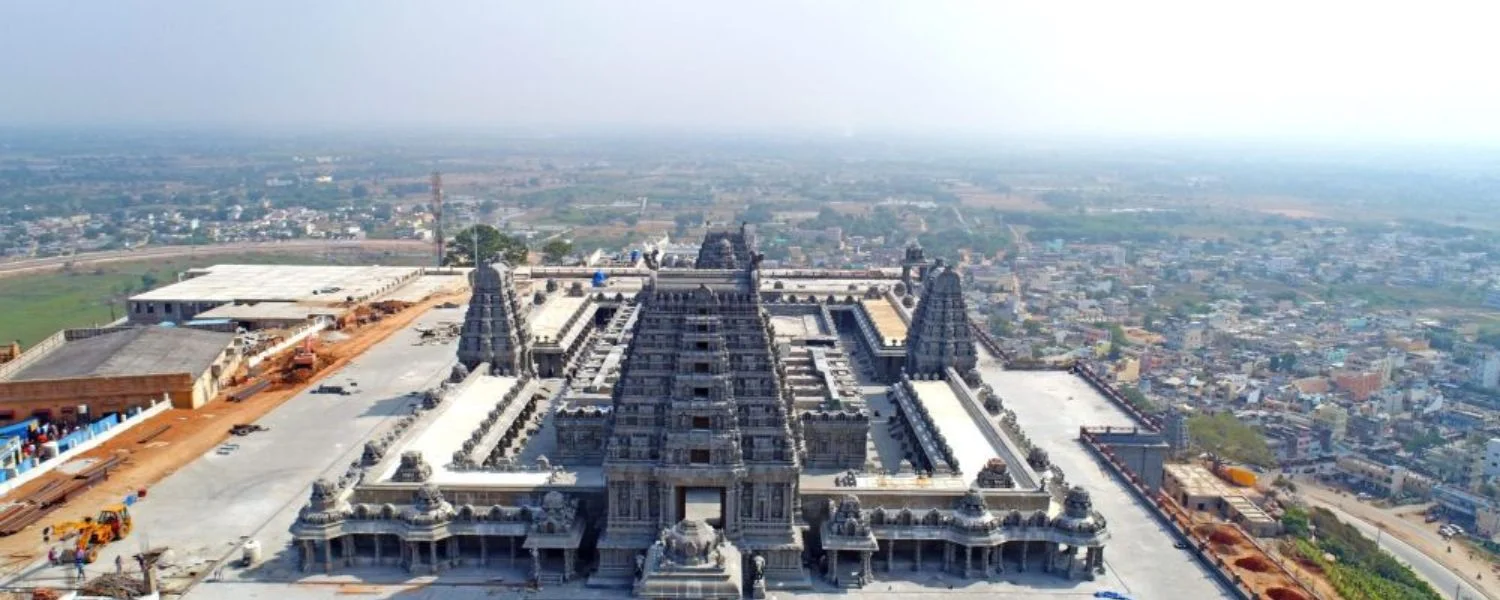
According to the Skanda Purana, Yada, the son of the sage Rishyasringa, performed rigorous penance at Yadagirigutta Temple, seeking the blessings of the god Narasimha.
Pleased with his devotion, Narasimha appeared in five distinct forms: Jvala Narasimha, Gandabherunda Narasimha, Yogananda Narasimha, Ugra Narasimha, and Lakshmi Narasimha.
Yada implored Narasimha to remain on the hill in these forms, thus giving rise to the temple’s unique significance.
Maintaining Yadagirigutta temple history adherence to the Tenkalai tradition of the Vaishnava Agama Shastras prevalent in South India, the temple stands as a testament to the deep-rooted spiritual heritage.
Deities in the Temple

Nestled within a cave, the temple houses various manifestations of Narasimha, each holding a distinct symbolic representation.
The main cave, which is 3.7 meters high and 9.1 meters long, leads to the sacred chamber where devotees encounter the awe-inspiring forms of Jvala Narasimha and Yogananda Narasimha.
Moreover, the silver icon of Lakshmi-Narasimha graces the main shrine, radiating divine grace upon devotees. Adjacent to the temple’s main entrance lies a shrine dedicated to Hanuman, symbolizing strength and devotion.
The presence of Gandaberunda Narasimha, manifested in a horizontal gap within the rock, further accentuates the temple’s aura of mystical reverence.
With the belief that sincere prayers here are answered, Yadagirigutta Temple stands as a beacon of faith and fulfillment for pilgrims seeking divine blessings.
New Yadadri Temple
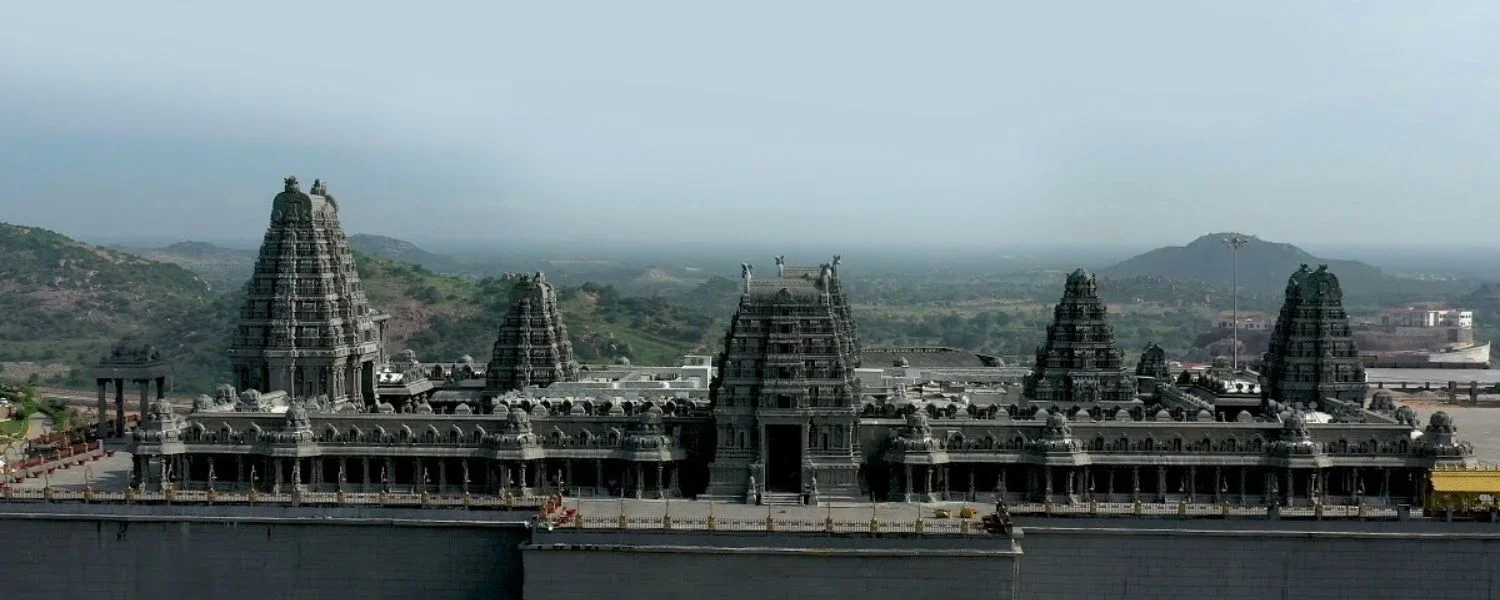
The venerable Yadagirigutta Temple, also known as the Yadadri Temple, underwent a remarkable transformation under the visionary leadership of the then CM of Telangana, K. Chandrashekhar Rao.
Commencing with the inauguration of a temporary Balalayam shrine, the reconstruction journey unfolded with meticulous planning and dedication.
Donations and Renovations
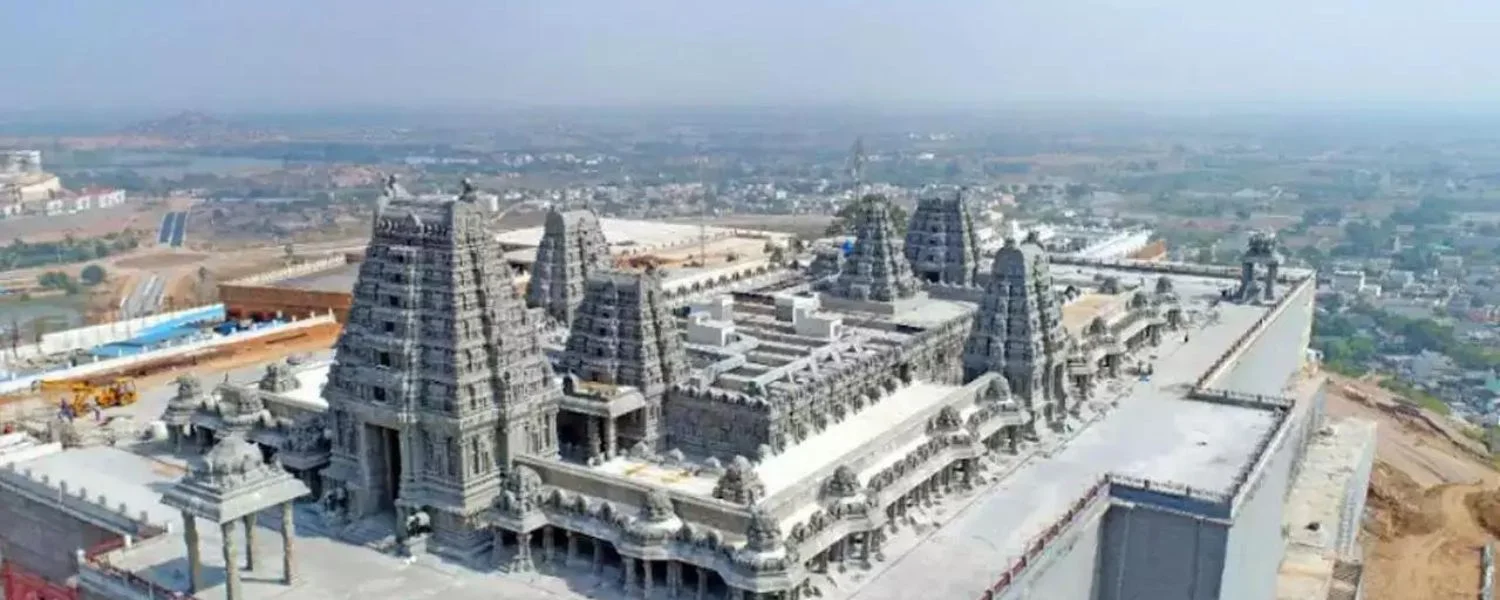
With an unwavering commitment to restore its former glory, Chief Minister K. Chandrashekhar Rao spearheaded a monumental renovation project backed by a substantial budget of ₹1800 crores.
This ambitious endeavor, initiated in 2016, saw the meticulous efforts of the Yadadri Temple Development Authority (YTDA), culminating in the temple’s grand reopening in March 2022.
Notably, the temple’s restoration embraced traditional craftsmanship, employing Krishna Sila (Black stone) and lime mortar techniques to ensure authenticity and longevity.
Generous contributions from various sources bolstered the renovation efforts, underscoring the temple’s cultural significance.
The temple’s treasury boasted an impressive cache of 39 kilos (gold) and 1,753 tonnes (silver), earmarked for embellishing its iconic gopurams and walls.
Additionally, the acquisition of 770 hectares (1,900 acres) of land, coupled with infrastructural enhancements such as housing near Vishnu Gundam, further enriched the temple’s precincts, and you can explore the monuments in Telangana.
Sections

However, at the heart of the temple complex lies the main temple, a divine sanctuary revered by countless devotees.
Adjacent to it, the Mukha Mandapam welcomes visitors with its New Yadagirigutta Temple inside craftsmanship and serene ambiance. Seven majestic gopurams, adorned with wooden roofs, punctuate the skyline, adding to the temple’s grandeur.
Within its sacred precincts, one can discover the Vratha peetham, an altar for solemn rituals, and the Swamy Vari Udyana Vanam, a verdant garden resonating with tranquility.
The Kalyana mandapam, resonating with sacred union ceremonies, and the stream, offering hospitality to weary travelers, further enrich the temple’s offerings.
Notably, the pillars of the main temple bear the imprints of 12 Alvars, revered poet-saints of Sri Vaishnavism, encapsulating centuries of spiritual wisdom.
Visitors pass through the temple entrance arch and are greeted by depictions of Mahābhūta, symbolizing the elemental forces that govern the universe.
Moreover, Vishnu Gundam, a sacred bathing pool, underscores the temple’s role in spiritual purification, where devotees cleanse themselves of worldly impurities.
Temple Architecture
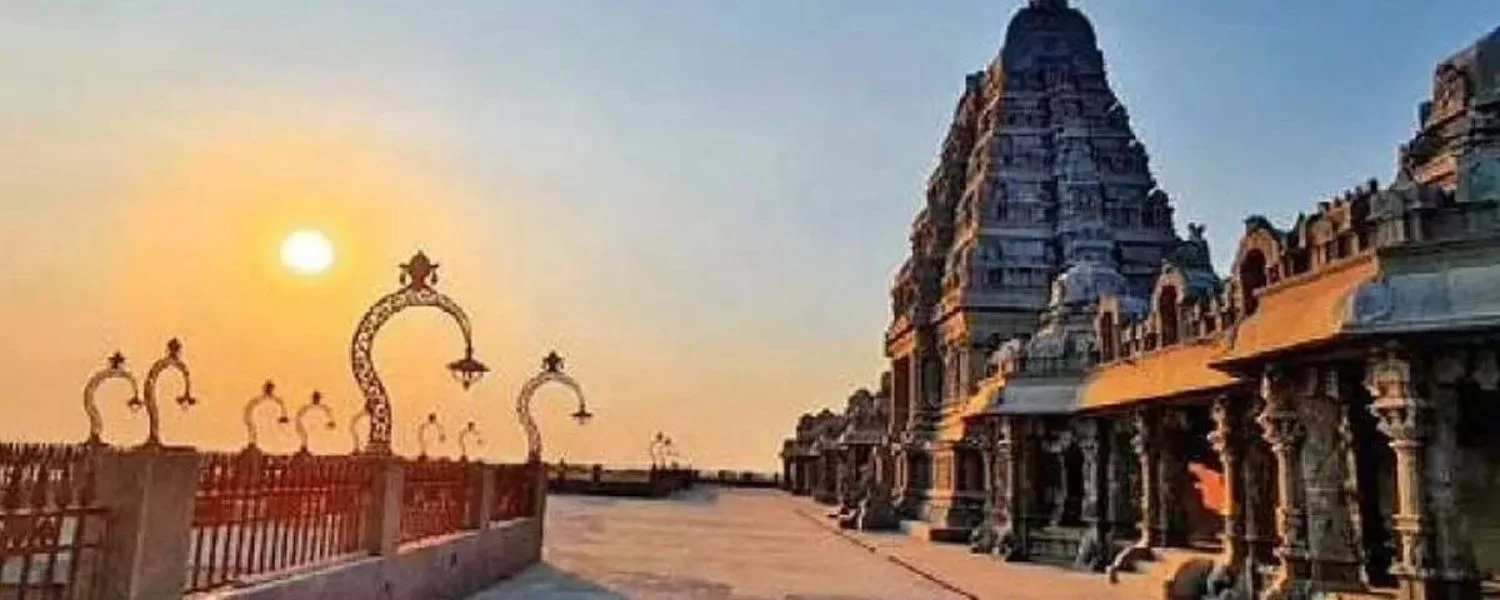
Imbued with the essence of Agama Shashtra, the temple’s architecture stands as a masterpiece of divine craftsmanship. Crafted entirely in stone, every edifice exudes timeless elegance and spiritual resonance.
Originally spanning 0.81 hectares (2 acres), the temple’s footprint has expanded to 6.5 hectares (16 acres) after the demolition of surrounding structures, enhancing its majesty and magnificence.
Design
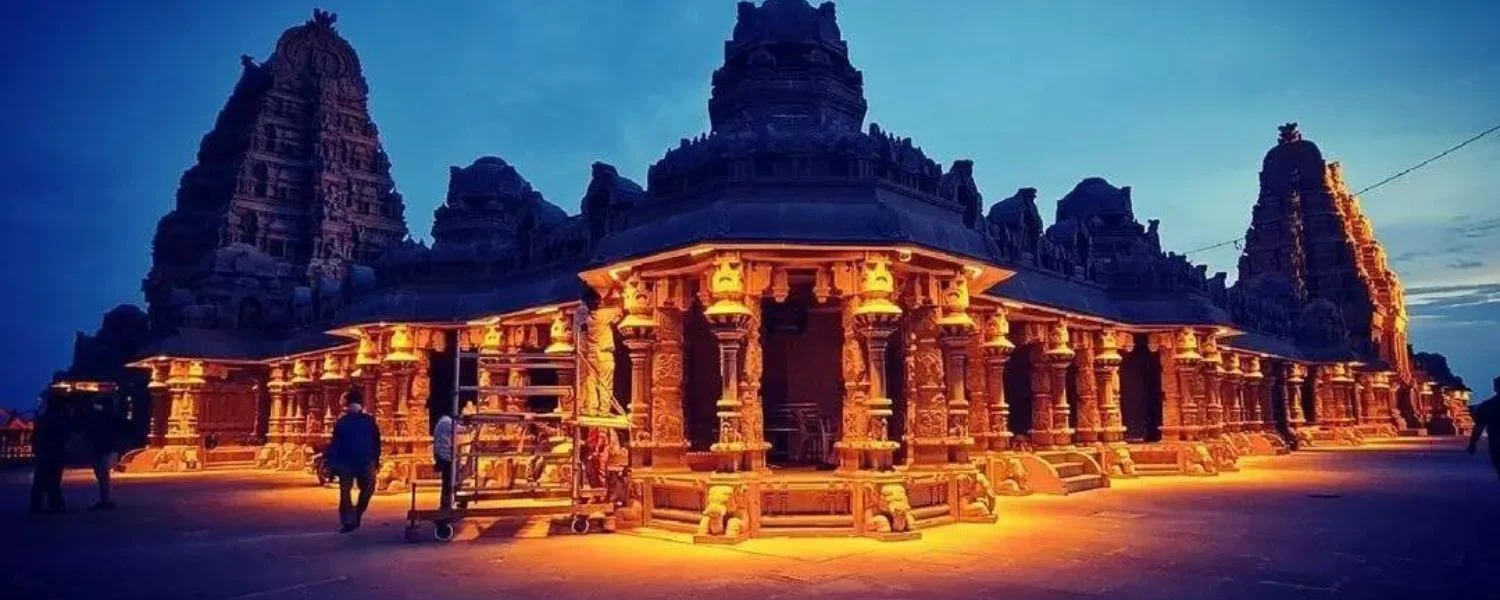
Anand Sai and P Madhusudhan, selected for their expertise, merge modern techniques with timeless wisdom. Every facet of the temple, from its grand facades to its serene sanctum, embodies the essence of ancient architectural ethos.
The Sthapathi’s vision intertwines seamlessly with the architects’ understanding, resulting in a structure transcending time.
A. Sculptures
The temple’s sculptures, a harmonious blend of tradition and innovation, are a marvel to behold. Napunsaka Sila, meanwhile, forms the foundation, walls, and more, contributing to the temple’s resplendence.
Three distinct types of stone grace its sacred precincts: Krishna Sila, revered as Purusha Sila, adorns the sanctum, while Sthri Sila finds its purpose in crafting goddesses’ idols.
Echoes of history resonate through the black granite stone, reminiscent of the Kakatiya dynasty’s architectural prowess.
Enriched with tiny pores, this stone gains strength and resilience by absorbing milk, curd, and oil, as imparted by learned shilipis.
Transport to Yadagirigutta Temple

Yadagirigutta Temple is conveniently accessible by both rail and road networks. The temple enjoys good connectivity, situated approximately 55 km from Uppal and 65 km from the Mahatma Gandhi Bus Station in Hyderabad.
A modern bus stand spanning 6.1 hectares has been constructed as part of the temple’s development, offering a hassle-free travel experience for pilgrims.
Additionally, the proposed Hyderabad Regional Ring Road is expected to pass through Yadagirigutta, further enhancing accessibility.
However, for those traveling by train, the nearest railway stations are Raigiri, located around 5 km away, and Bhuvanagiri, a significant town in the Hyderabad Metropolitan Region, approximately 13 km from the temple.
Raigiri railway station has been renamed Yadadri (YADD) by the South Central Railway, aligning with the temple town’s nomenclature.
Plans are underway to extend the Hyderabad MMTS – Phase II from Ghatkesar to Raigiri station, just 5 km from Yadagirigutta.
Moreover, there is a proposal for a metro train service between Uppal and Yadagirigutta, promising even more convenient transportation options in the future.
Festivals at Yadagirigutta Temple

Yadagirigutta Temple hosts several vibrant festivals throughout the year, drawing devotees from far and wide.
A. Brahmothsavams
One of the most significant celebrations is the Sri Swamy Vari Brahmothsavams, held annually from Shudha Vidiya to Dwadasi, typically falling between February and March.
Lasting for eleven days, these festivities feature a rich array of cultural programs, including Harikathas, Bhajans, Upanyasams, Bharatanatyam performances, and dramas.
Renowned artists and scholars from various parts of the country are invited to participate, adding to the event’s grandeur.
B. Narasimha Jayanthi
Commemorating the day Lord Vishnu manifested in his half-human, half-lion form to rescue his devoted follower, Prahlad, from the demon Hiranyakashipu.
During this auspicious occasion, special Parayanams such as Ramayan, Mahabharat, Bhagavad Gita, and Kshetra Mahathyam are organized, enriching the spiritual atmosphere of the Brahmothsavams and Narasimha Jayanthi.
Furthermore, visiting Peethadhipathis and Mathadhipathis delivers enlightening Pravachanams to the devotees, enhancing their spiritual experience.
C. Swathi Sangeethotsvam
Additionally, Yadagirigutta Temple celebrates the Swathi Sangeethotsvam, a music festival observed in South India.
On every Swathi Nakshatram, which marks the birth star of Swamy Varu, the temple conducts Sri Swamy Vari Astothara Satha Ghatabhisekam, according to Agama Shastra.
This ritual commences at 4:30 am and continues until 7:00 am, offering devotees the opportunity to participate by paying a nominal fee of INR 750 for two people.
Other Activities at Yadagirigutta Temple

Yadagirigutta Temple isn’t just a place of worship; it’s a hub of various activities catering to different interests and needs. Besides the regular religious ceremonies and rituals, the temple fosters cultural and educational initiatives.
One such endeavor is the ‘Vidya Peetham’ sessions to enlighten the younger generation about their religious heritage and ancestors. These sessions connect the past with the present, instilling a sense of reverence and understanding among the youth.
Moreover, within the temple premises lies a Gaushala, a sanctuary for cows, buffalos, and other livestock. This Gaushala serves as a compassionate shelter and plays a vital role in the temple’s daily rituals.
The milk required for the sacred ‘Nivedhana’ offered to the deities is sourced from this in-house sanctuary, ensuring purity and adherence to tradition.
Prasadams at Yadagirigutta Temple

One of the highlights of visiting Yadagirigutta Temple is the opportunity to relish its divine prasadam. Every day, after the completion of rituals, the temple distributes approximately 105 kgs of prasadam to devotees, free of charge.
Dedicated counters, including special ones for ladies, operate from 7:00 am to 9:00 pm, ensuring accessibility to all.
For those desiring to take home more of this blessed offering, additional prasadam is available for purchase at nominal prices, ensuring that everyone can partake in the temple’s spiritual bounty and taste Telangana’s famous food.
How To Reach Yadagirigutta Temple

Located a mere 60 km away from the bustling city of Hyderabad, reaching Yadagirigutta Temple is convenient and hassle-free. The temple is well-connected by both rail and road networks.
The nearest railway station, Raigiri Railway Station, is a 3 km drive away, approximately 15 minutes by road. Upon arrival, visitors can easily hire a cab or an auto-rickshaw to reach the temple premises.
For a more traditional experience, one can opt for a Tanga, a carriage drawn by horses, adding a touch to the journey.
Conclusion
In conclusion, the Yadagirigutta Temple is a majestic symbol of devotion and spirituality, drawing pilgrims from all corners of the globe.
Beyond its mythological significance, the temple’s meticulous renovation under Chief Minister K. Chandrashekhar Rao’s leadership has elevated its grandeur, reflecting Telangana’s rich cultural heritage.
Furthermore, its accessibility via rail and road networks ensures a hassle-free journey for devotees. The temple’s vibrant festivals, educational initiatives, and compassionate endeavors like the Gaushala enrich the spiritual experience, fostering a sense of community and reverence.
As visitors partake in the divine prasadam and immerse themselves in the temple’s serene ambiance, they find solace and fulfillment in the presence of Lord Narasimha.
FAQ
Q: How much time will it take for darshan in Yadagirigutta?
A: Yadagirigutta Temple darshan timings typically take 2 to 3 hours on weekends, holidays, and auspicious days. The temple is open from 4 am to 9 pm daily.
Q: What is the cost of VIP darshan in Yadagirigutta temple?
A: VIP darshan at Yadagirigutta Temple is available 4:00 pm to 5:00 pm and costs Rs. 300 per person. Please note that Yadagirigutta temple timings and costs are subject to change, so it is recommended that you check the official website for updates.
Q: Why is Yadagirigutta famous?
A: Yadagirigutta is famous as the divine abode of Lord Narasimha, attracting devotees seeking blessings and spiritual fulfillment.
Q: How much time does VIP darshan take?
A: VIP darshan typically takes 1 to 2 hours, but it may take longer during peak seasons. VIP break darshan provides a quicker alternative, but there may still be wait times.
For More: YADAGIRIGUTTA TEMPLE
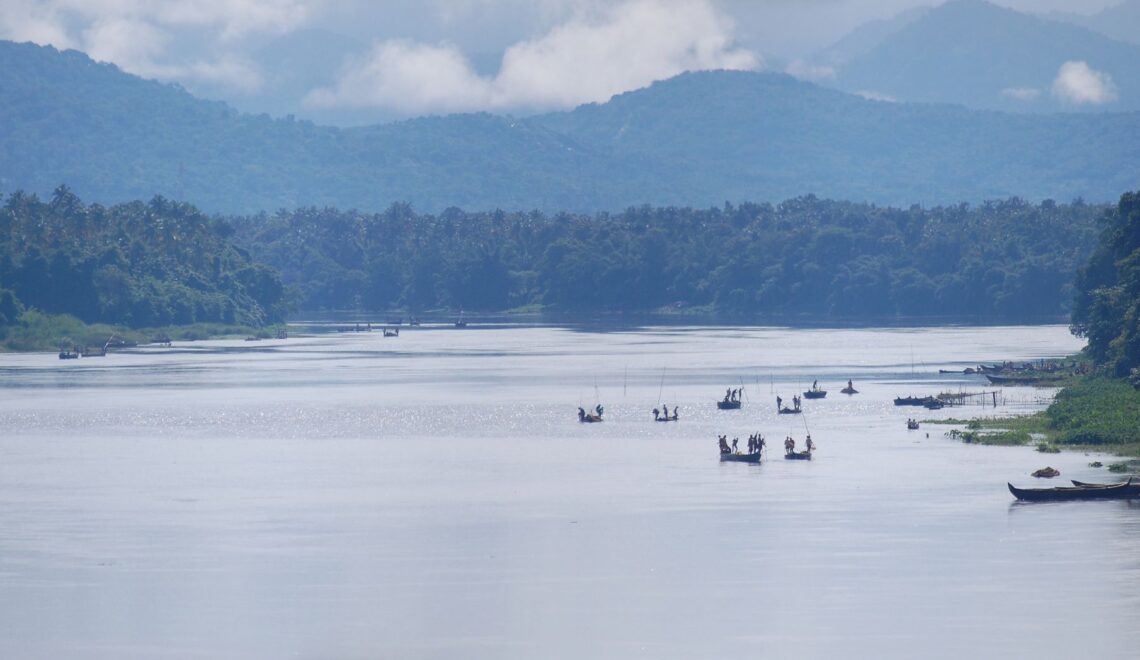














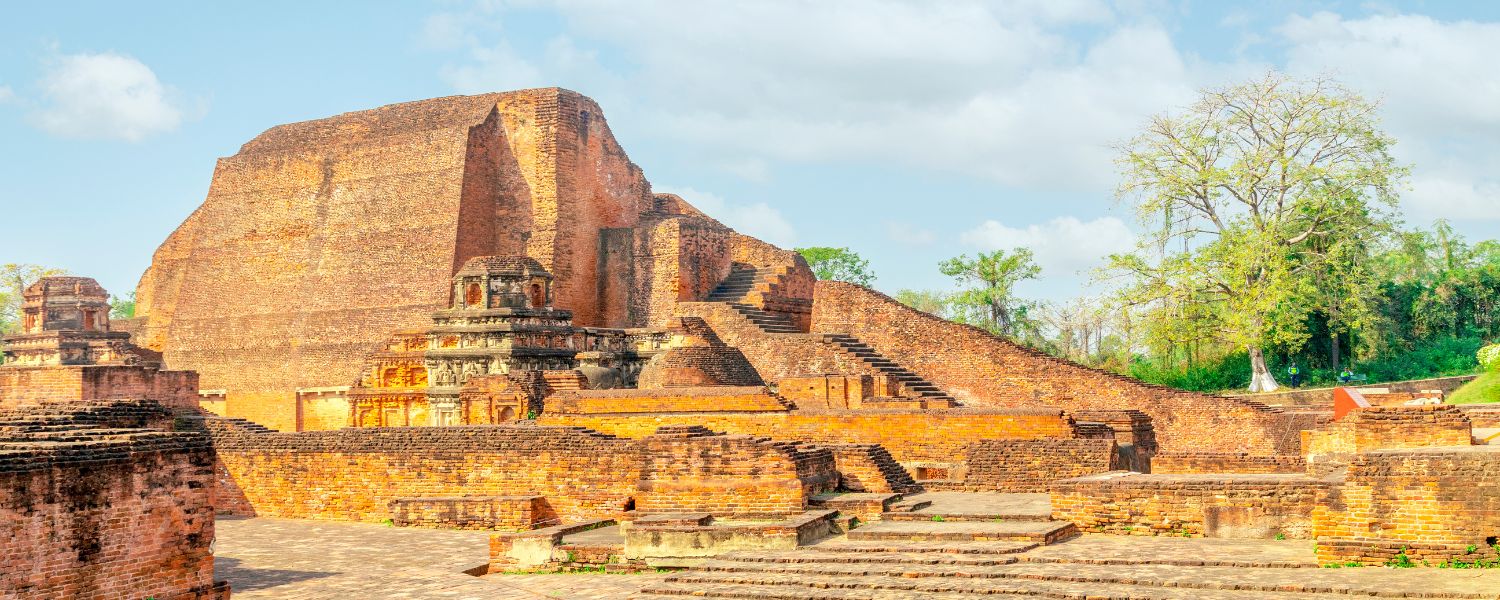
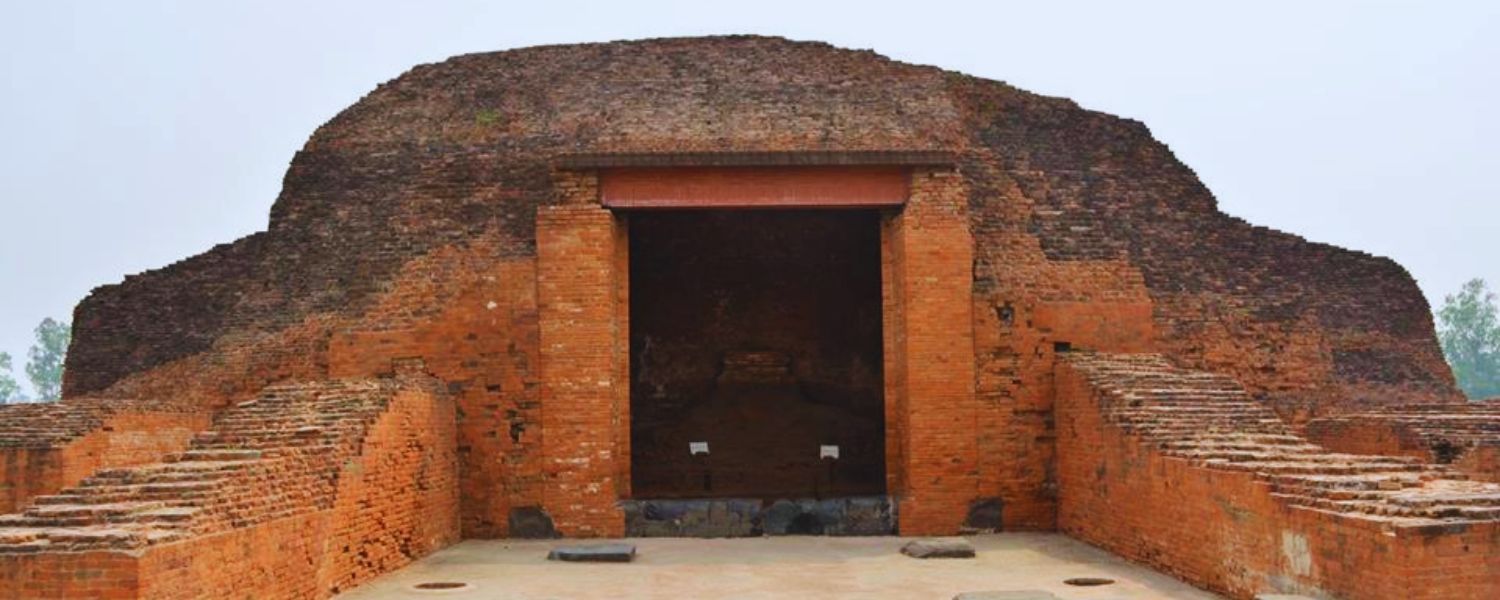
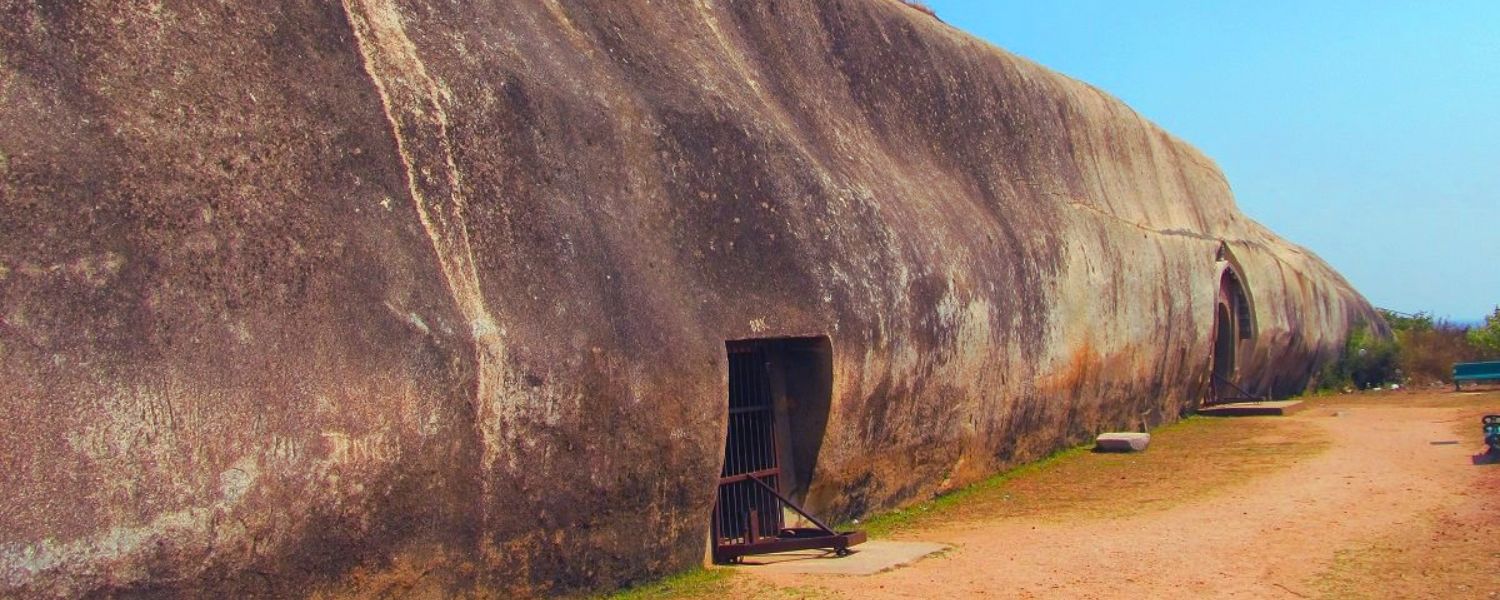
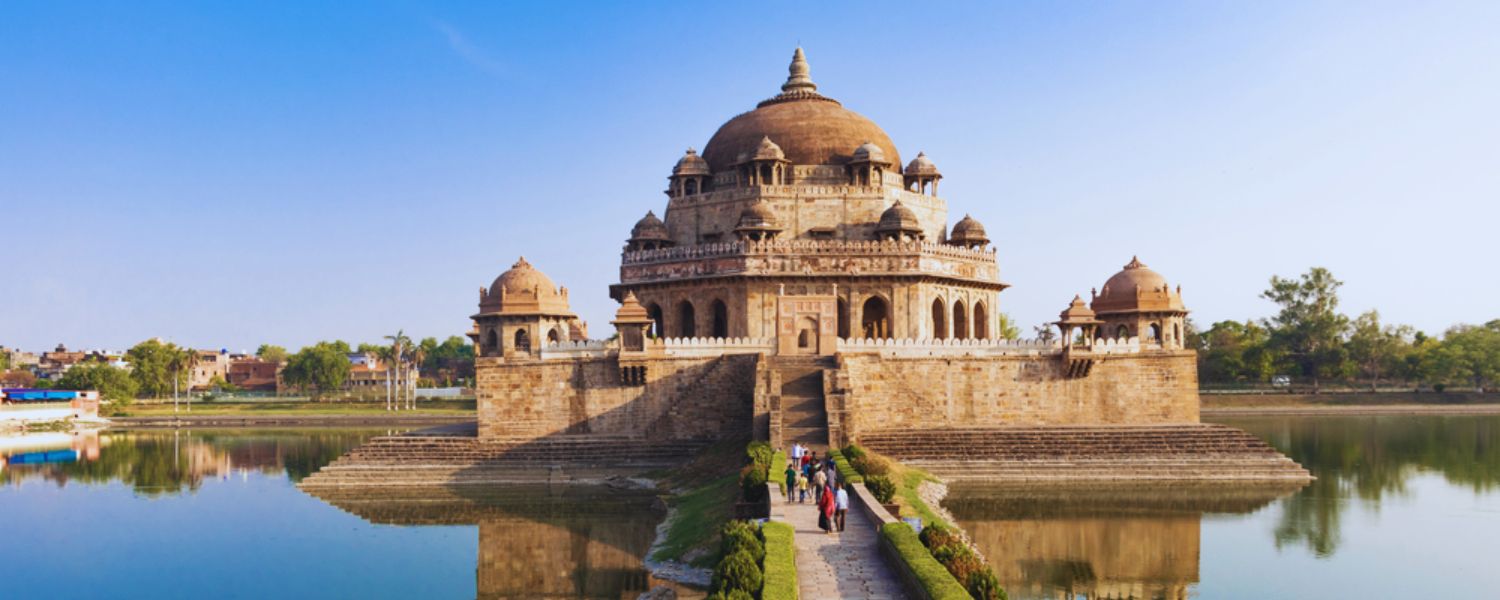

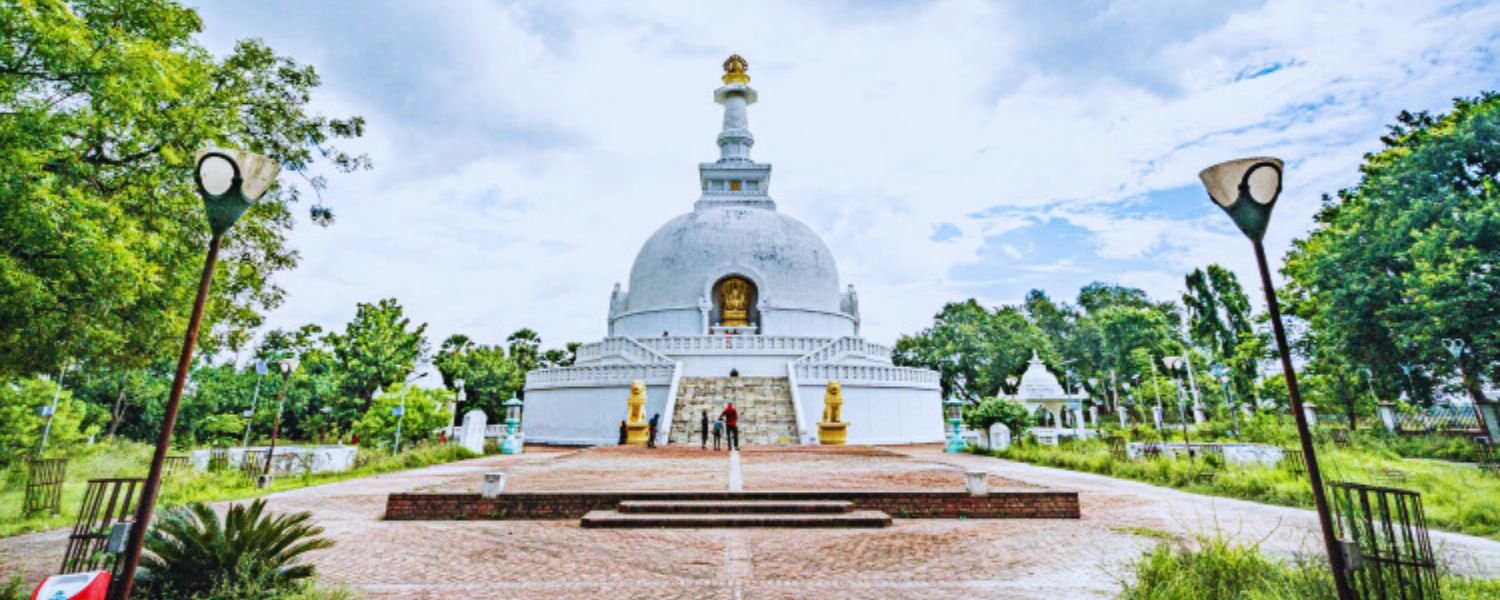
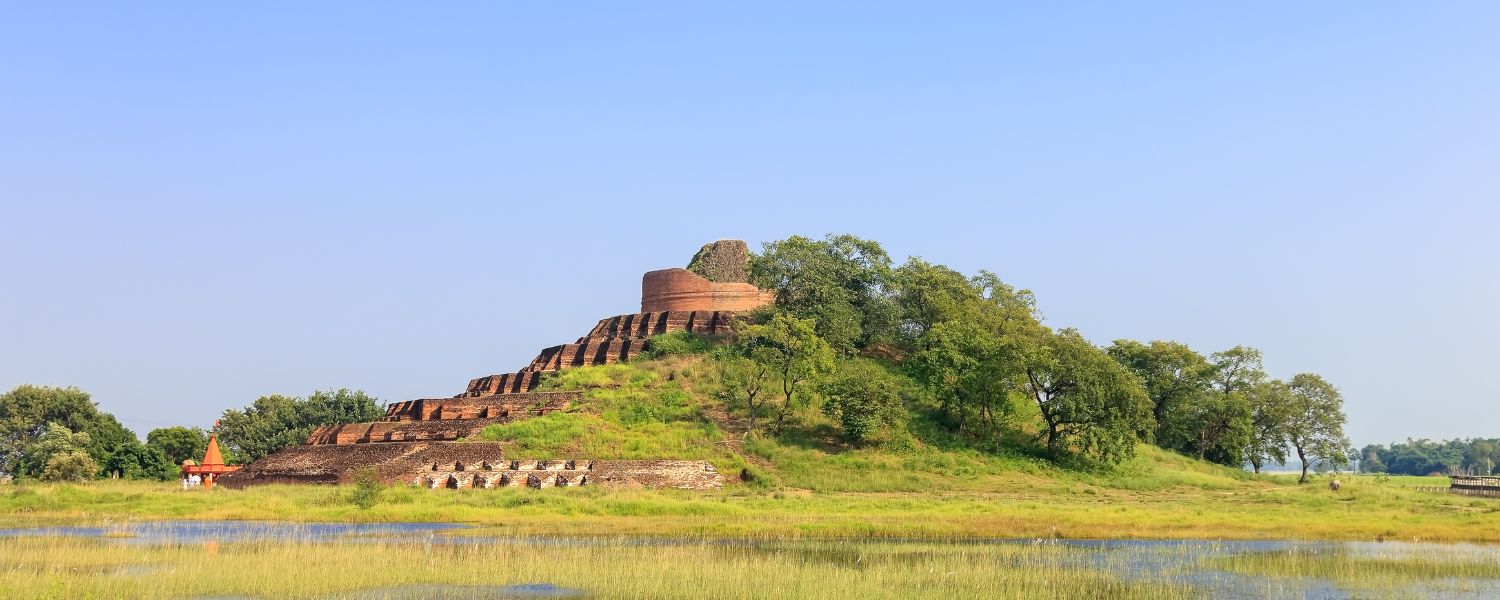

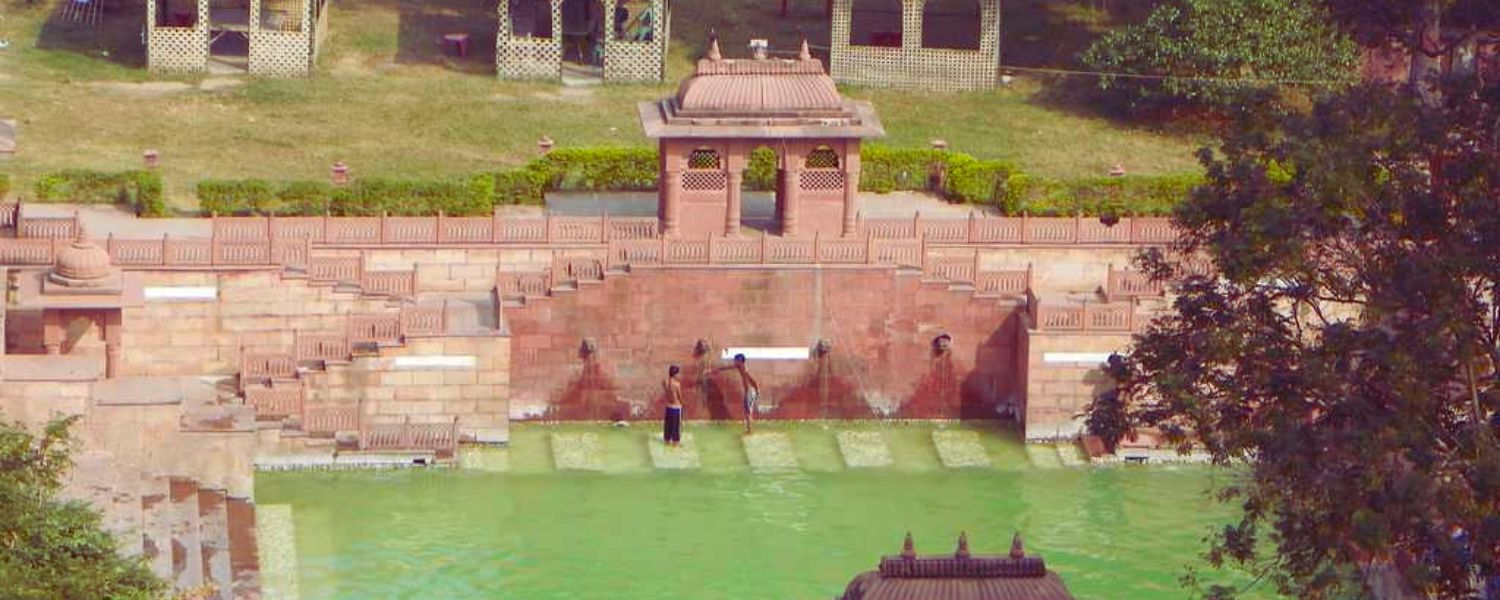

.jpg)
